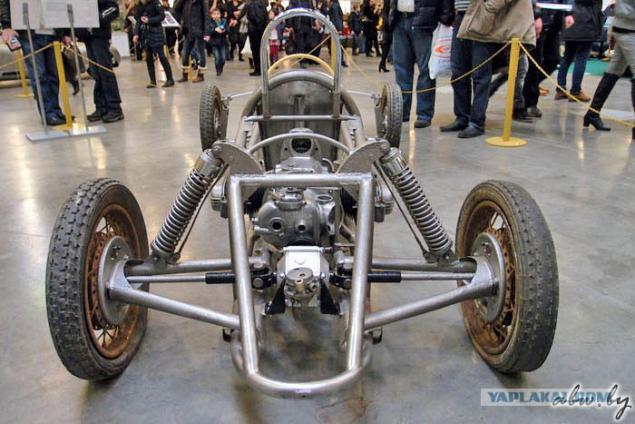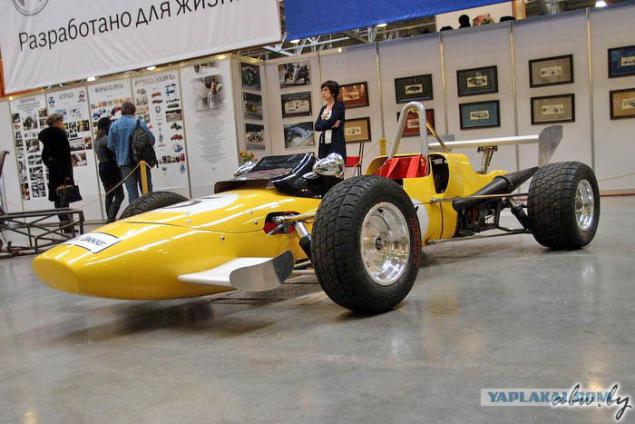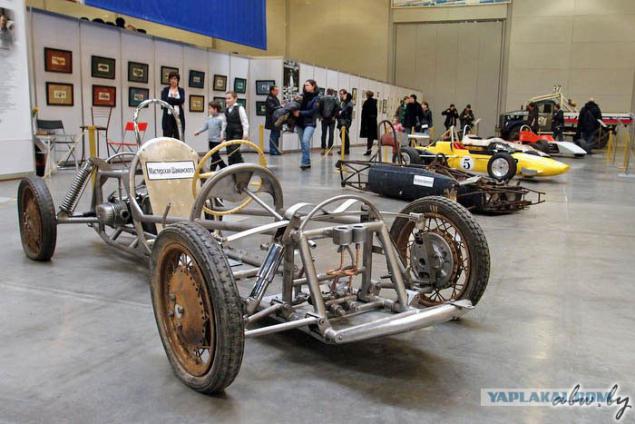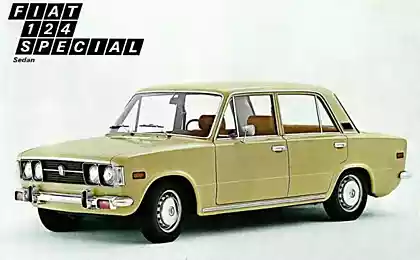938
Racing cars and a record of the Soviet Union.
There was a time - they shone on the sports tracks, set records and admire its appearance, strength and speed. Today it exhibits a thematic exhibition "Legends of Soviet motorsports" on XXI «Oldtimer-Gallery».
20 photos and some text under the cut
a source at the end of

02

"Estonia-3" - the first Soviet car racing, mass-produced (in 1960-1962. Commissioned by CA DOSAAF was released 36 cars). Further development of the concept by the design of the first "Estonia", has brought a number of differences: a lightweight spatial tubular frame, rear independent suspension with coil springs as elastic elements (instead of transverse springs), motorcycle engine IMZ-M52S developed is no longer 30, and 35 liters. from.

04

"Estonia-15M" is the basic model class Formula-4 "Youth" for vehicles with an engine capacity of 350 cubic meters. cm. The car was originally designed as a simple and inexpensive to manufacture and maintain, and proved to be quite massive: in the 1968-1976 biennium. It was issued more than 200 (!) cars. They have been used in competitions until the end of 1983 when the "Youth" was excluded from the All-Union classification.

The main race cars on the Soviet ring lines of the first half of 1980 was the "Estonia-20", which is a further evolution of the 19-series. The main changes concern the aerodynamics. In particular, the design was initially front and rear spoilers with adjustable angle of attack. The engine VAZ-21011 of 1, 3 l, prepared according to the requirements of the formula "East", developed 85-90 hp In 1980-1985. 263 car was released, one of them was the thousandth race cars, the company issued TOARZ (by the way, the selling price, "Estonia 20" is 8000 rubles). The car took part in competitions until the end of the 1980s.

07

And this "Estonia-25" more recently in Belarus "ring" went Andrei Presnyakov ...

Who remembers the ambitious project 20 years ago, when the German Johann Knapp tried to organize the production of "formulas" not somewhere, namely in Minsk? One of the creations of a joint venture became the JAK 26 with carbon-fiber monocoque and quite advanced for its time, a technical stuffing ...

A prototype of this "formula" "Rus". Unlike mass-produced cars, motors are equipped with Alfa Romeo, this chassis has been installed the engine VAZ-2108 160 hp

11

"Kiev-Sport" (1952) is unique in at least the fact that its design was developed by the Kiev aviation design bureau (now OKB Antonov). The carrier element here is the space frame from thin-walled steel pipes, external panels made of aluminum bonded together by riveting. It is also used for aircraft hatches fillers and marker lights. There were built a few cars, but it is on this, equipped with an engine from the "Moskvich-407" capacity of 70-75 hp, 1960 Yuri Likhatskaya he became the silver medalist of the USSR on the highway-circular races.

13

14

"Tartu-1" - is not an ordinary "Estonia", built in 1963 to participate in the racing circuit. The chassis was a space frame of steel pipes, the engine GAZ-21, interlocked with manual transmission ZAZ-965, located in front of the rear axle, the pilot's seat is shifted to the right for reasons of weight distribution. To access the nodes of its solid steel car body up completely. "Tartu-1" exhibited in race of the season 1963-1965.

16

17

Perhaps the greatest interest among the visitors and experts summoned record cars by Edouard Laurent. And let the background of the restored first Soviet dragster "Kharkiv-L3" remains in an authentic state of "Kharkov-L2" looks modest, it is on account of his 30 records, including 14 international, set in 1955- 1972. Edward Laurent and his son Valery!

19

With the collapse of the Union of motorsport industry went into decline, after years of technique "confused" in the former state ... However, many vehicles, including unique exhibits have survived, and there is no doubt the efforts of restorers will find its original appearance. Let's wait!
source

Source:
20 photos and some text under the cut
a source at the end of

02

"Estonia-3" - the first Soviet car racing, mass-produced (in 1960-1962. Commissioned by CA DOSAAF was released 36 cars). Further development of the concept by the design of the first "Estonia", has brought a number of differences: a lightweight spatial tubular frame, rear independent suspension with coil springs as elastic elements (instead of transverse springs), motorcycle engine IMZ-M52S developed is no longer 30, and 35 liters. from.

04

"Estonia-15M" is the basic model class Formula-4 "Youth" for vehicles with an engine capacity of 350 cubic meters. cm. The car was originally designed as a simple and inexpensive to manufacture and maintain, and proved to be quite massive: in the 1968-1976 biennium. It was issued more than 200 (!) cars. They have been used in competitions until the end of 1983 when the "Youth" was excluded from the All-Union classification.

The main race cars on the Soviet ring lines of the first half of 1980 was the "Estonia-20", which is a further evolution of the 19-series. The main changes concern the aerodynamics. In particular, the design was initially front and rear spoilers with adjustable angle of attack. The engine VAZ-21011 of 1, 3 l, prepared according to the requirements of the formula "East", developed 85-90 hp In 1980-1985. 263 car was released, one of them was the thousandth race cars, the company issued TOARZ (by the way, the selling price, "Estonia 20" is 8000 rubles). The car took part in competitions until the end of the 1980s.

07

And this "Estonia-25" more recently in Belarus "ring" went Andrei Presnyakov ...

Who remembers the ambitious project 20 years ago, when the German Johann Knapp tried to organize the production of "formulas" not somewhere, namely in Minsk? One of the creations of a joint venture became the JAK 26 with carbon-fiber monocoque and quite advanced for its time, a technical stuffing ...

A prototype of this "formula" "Rus". Unlike mass-produced cars, motors are equipped with Alfa Romeo, this chassis has been installed the engine VAZ-2108 160 hp

11

"Kiev-Sport" (1952) is unique in at least the fact that its design was developed by the Kiev aviation design bureau (now OKB Antonov). The carrier element here is the space frame from thin-walled steel pipes, external panels made of aluminum bonded together by riveting. It is also used for aircraft hatches fillers and marker lights. There were built a few cars, but it is on this, equipped with an engine from the "Moskvich-407" capacity of 70-75 hp, 1960 Yuri Likhatskaya he became the silver medalist of the USSR on the highway-circular races.

13

14

"Tartu-1" - is not an ordinary "Estonia", built in 1963 to participate in the racing circuit. The chassis was a space frame of steel pipes, the engine GAZ-21, interlocked with manual transmission ZAZ-965, located in front of the rear axle, the pilot's seat is shifted to the right for reasons of weight distribution. To access the nodes of its solid steel car body up completely. "Tartu-1" exhibited in race of the season 1963-1965.

16

17

Perhaps the greatest interest among the visitors and experts summoned record cars by Edouard Laurent. And let the background of the restored first Soviet dragster "Kharkiv-L3" remains in an authentic state of "Kharkov-L2" looks modest, it is on account of his 30 records, including 14 international, set in 1955- 1972. Edward Laurent and his son Valery!

19

With the collapse of the Union of motorsport industry went into decline, after years of technique "confused" in the former state ... However, many vehicles, including unique exhibits have survived, and there is no doubt the efforts of restorers will find its original appearance. Let's wait!
source

Source:























